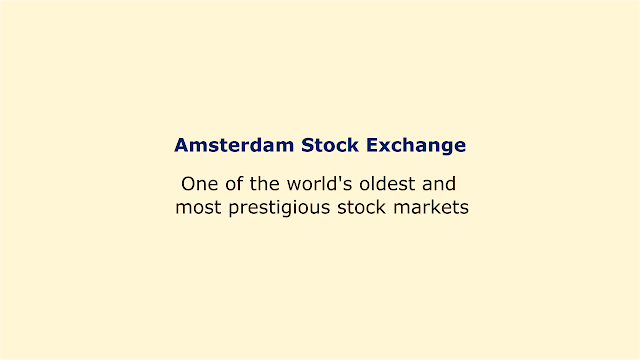 |
| Image: Moneybestpal.com |
The Amsterdam Stock Exchange is one of the world's oldest and most prestigious stock markets. Its history begins in the 17th century when the Dutch East India Company (VOC) issued shares to fund its trade activities in Asia.
The VOC was the first business to sell stock to the general public, and as a result of its trading activity, Amsterdam's secondary market for securities was born. The Amsterdam Stock Exchange developed into a center for global trade and innovation, luring traders and investors from all around Europe and beyond.
The Amsterdam Stock Exchange is now a part of Euronext, a pan-European stock exchange and market infrastructure that links the economies of Europe to international financial markets. Ambitious businesses from the Netherlands and overseas can access the global capital markets through Euronext Amsterdam, which also links the various market players. Together with domestic small and mid-sized businesses, it is home to some of the most prestigious global corporations, like Adyen, ASML, Marel, and Prosus. Additionally, it offers a selection of goods and services for market participants, institutional and private investors, and professional traders.
The Amsterdam Stock Exchange uses the cutting-edge trading platform Optiq, which provides high performance, low latency, and expanded functionality. The platform offers a number of trading areas, including equities, derivatives, bonds, funds, exchange-traded products, and commodities. The Amsterdam Stock Exchange also places a high priority on sustainability and social responsibility, supporting programs like green bonds, social bonds, sustainable indices, and corporate governance standards.
The Amsterdam Stock Exchange is situated in the center of the city's financial area at Beursplein 5. Hendrik Petrus Berlage, a famous architect, created the recognizable structure in 1903. With hints of Art Nouveau and Art Deco, it has a neo-Renaissance look. Events held there include press conferences, workshops, product launches, bell ceremonies, and private dinners. Visitors who wish to learn more about the stock exchange's past and current operations are also welcome inside the structure.
The Amsterdam Stock Exchange is a representation of the openness and dynamism of the Dutch economy. It displays the nation's rich history of invention and trade as well as its dedication to global collaboration and European integration. The Amsterdam Stock Exchange serves as more than just a venue for stock trading; it also serves as a hub for the interchange of ideas, the development of new companies, the seizing of opportunities, and the creation of social value.
The Amsterdam Stock Exchange is now a part of Euronext, a pan-European stock exchange and market infrastructure that links the economies of Europe to international financial markets. Ambitious businesses from the Netherlands and overseas can access the global capital markets through Euronext Amsterdam, which also links the various market players. Together with domestic small and mid-sized businesses, it is home to some of the most prestigious global corporations, like Adyen, ASML, Marel, and Prosus. Additionally, it offers a selection of goods and services for market participants, institutional and private investors, and professional traders.
The Amsterdam Stock Exchange uses the cutting-edge trading platform Optiq, which provides high performance, low latency, and expanded functionality. The platform offers a number of trading areas, including equities, derivatives, bonds, funds, exchange-traded products, and commodities. The Amsterdam Stock Exchange also places a high priority on sustainability and social responsibility, supporting programs like green bonds, social bonds, sustainable indices, and corporate governance standards.
The Amsterdam Stock Exchange is situated in the center of the city's financial area at Beursplein 5. Hendrik Petrus Berlage, a famous architect, created the recognizable structure in 1903. With hints of Art Nouveau and Art Deco, it has a neo-Renaissance look. Events held there include press conferences, workshops, product launches, bell ceremonies, and private dinners. Visitors who wish to learn more about the stock exchange's past and current operations are also welcome inside the structure.
The Amsterdam Stock Exchange is a representation of the openness and dynamism of the Dutch economy. It displays the nation's rich history of invention and trade as well as its dedication to global collaboration and European integration. The Amsterdam Stock Exchange serves as more than just a venue for stock trading; it also serves as a hub for the interchange of ideas, the development of new companies, the seizing of opportunities, and the creation of social value.
